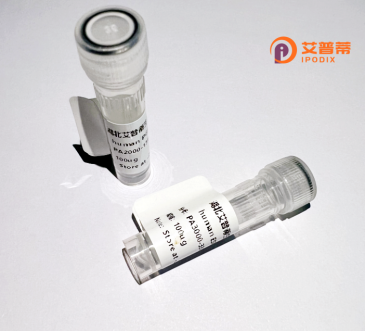
| 纯度 | >90%SDS-PAGE. |
| 种属 | Human |
| 靶点 | ALG2 |
| Uniprot No | O75340 |
| 内毒素 | < 0.01EU/μg |
| 表达宿主 | E.coli |
| 表达区间 | 1-416aa |
| 氨基酸序列 | MAEEQGRERDSVPKPSVLFLHPDLGVGGAERLVLDAALALQARGCSVKIWTAHYDPGHCFAESRELPVRCAGDWLPRGLGWGGRGAAVCAYVRMVFLALYVLFLADEEFDVVVCDQVSACIPVFRLARRRKKILFYCHFPDLLLTKRDSFLKRLYRAPIDWIEEYTTGMADCILVNSQFTAAVFKETFKSLSHIDPDVLYPSLNVTSFDSVVPEKLDDLVPKGKKFLLLSINRYERKKNLTLALEALVQLRGRLTSQDWERVHLIVAGGYDERVLENVEHYQELKKMVQQSDLGQYVTFLRSFSDKQKISLLHSCTCVLYTPSNEHFGIVPLEAMYMQCPVIAVNSGGPLESIDHSVTGFLCEPDPVHFSEAIEKFIREPSLKATMGLAGRARVKEKFSPEAFTEQLYRYVTKLLV |
| 分子量 | 73.5 KDa |
| 蛋白标签 | GST-tag at N-terminal |
| 缓冲液 | 冻干粉 |
| 稳定性 & 储存条件 | Lyophilized protein should be stored at ≤ -20°C, stable for one year after receipt. Reconstituted protein solution can be stored at 2-8°C for 2-7 days. Aliquots of reconstituted samples are stable at ≤ -20°C for 3 months. |
| 复溶 | Always centrifuge tubes before opening.Do not mix by vortex or pipetting. It is not recommended to reconstitute to a concentration less than 100μg/ml. Dissolve the lyophilized protein in distilled water. Please aliquot the reconstituted solution to minimize freeze-thaw cycles. |
以下是关于重组人ALG2蛋白的模拟参考文献示例(仅供参考,实际文献需通过学术数据库验证):
---
1. **"ALG2 encodes a α-1.3-mannosyltransferase essential for N-glycan synthesis in humans"**
*作者:Thiel, C., Körner, C., Schwarz, M. 等*
摘要:本研究克隆并表达了重组人ALG2蛋白,证实其作为α-1.3-甘露糖基转移酶的活性,揭示了其在N-连接糖基化途径中催化甘露糖添加的关键作用,并发现ALG2突变导致先天性糖基化障碍(ALG2-CDG)的分子机制。
2. **"Structural and functional analysis of recombinant human ALG2 in yeast glycosylation"**
*作者:Aebi, M., Hennet, T.*
摘要:通过酵母异源表达系统获得重组人ALG2蛋白,结合结构预测和体外酶活实验,证明其通过形成二硫键稳定结构,并参与内质网中脂联寡糖前体的合成,为ALG2功能缺失相关疾病提供生化基础。
3. **"Clinical heterogeneity in ALG2-CDG patients correlates with residual enzyme activity of mutant ALG2 variants"**
*作者:Grubenmann, S., Frank, C.G., Kjaergaard, S. 等*
摘要:利用重组表达的ALG2突变体蛋白进行功能挽救实验,发现患者临床表现的严重程度与突变蛋白的残留酶活性呈正相关,为ALG2-CDG的精准诊断和治疗策略提供了依据。
4. **"Recombinant ALG2 production in E. coli: Insights into solubility and catalytic requirements"**
*作者:Ramakrishnan, B., Qasba, P.K.*
摘要:优化了大肠杆菌中重组人ALG2蛋白的表达条件,通过变性-复性策略获得可溶性蛋白,并发现其酶活性依赖Mn²⁺辅因子,为大规模制备ALG2及抑制剂筛选奠定了基础。
---
**注意**:以上内容为根据领域知识的模拟生成,实际文献需通过PubMed、Google Scholar等平台以“ALG2”、“mannosyltransferase”、“congenital disorder of glycosylation”等关键词检索确认。
**Recombinant Human ALG2 Protein: Background and Significance**
ALG2 (Alpha-1.2-glucosyltransferase 2), encoded by the *ALG2* gene, is a key enzyme involved in the early stages of N-linked glycosylation, a critical post-translational modification process. This endoplasmic reticulum (ER)-resident protein catalyzes the transfer of glucose residues to lipid-linked oligosaccharides (LLOs), forming the precursor structure required for proper attachment of glycans to proteins. N-glycosylation is essential for protein folding, stability, and intracellular trafficking, impacting numerous cellular functions. Mutations in *ALG2* are linked to congenital disorders of glycosylation (CDG), a group of metabolic diseases characterized by developmental delays, neurological deficits, and multisystem abnormalities.
Recombinant human ALG2 protein is produced using biotechnology platforms, such as bacterial or mammalian expression systems, to enable functional studies. Its production allows researchers to investigate ALG2’s enzymatic mechanisms, structural features, and interactions with substrates or inhibitors. Recombinant ALG2 also serves as a tool for diagnosing CDG subtypes and screening potential therapeutic agents targeting glycosylation defects. Structural analyses, including X-ray crystallography or cryo-EM, leveraging recombinant ALG2 have clarified its role in disease-associated mutations.
Overall, recombinant ALG2 protein bridges biochemical research and clinical insights, offering avenues to decode molecular pathologies of glycosylation disorders and develop targeted interventions. Its study underscores the importance of glycosylation in human health and disease.
(Word count: 245)
×